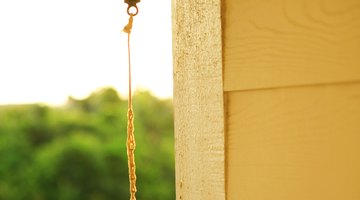How to Restore an Iron Farm Bell
A call to dinner or the sound of alarm were made by cast-iron farm bells in centuries past. The bell, first developed in 400 A.D. by Bishop Paulinus of Campagnia, was an important communication device.

Many of those cherished farm bells were passed down through generations; however, when cast iron is exposed to the elements, rust develops over time. Restoration requires rust removal and coating with a protectant.
Things You Will Need
- Phosphoric acid
- Wire brush
- Bristle brush
- Water
- 1/2 cup baking soda
- Alkyd rust-inhibitive primer paint
- Paint brush
- Alkyd enamel paint
Tip
Cola drink may be used instead of phosphoric acid. Submerge the bell in cola, and leave it only until rust has softened. If you prefer not to paint your farm bell, spray the bell with a coat of WD-40. Recoat annually to protect the bell from corrosion.
-
Brush your cast-iron bell using a wire brush to remove loose rust.
-
Submerge the bell in diluted phosphoric acid to loosen rust, and lightly etch to expose a clean, fresh surface. Follow manufacturer's instructions for dilution rates and submersion times. Use the minimum submersion time to avoid unnecessary etching of the iron.
-
Remove the bell from the phosphoric acid solution, and brush with a stiff bristle brush or a wad of aluminum foil.
-
Mix approximately 1/2 cup of baking soda in a gallon of water. Rinse the farm bell inside and out thoroughly with the baking soda solution to neutralize any phosphoric acid residue.
-
Rinse the bell with clear water and allow to dry thoroughly.
-
Apply two coats of alkyd rust-inhibitive primer paint to the bell. Allow to dry between coats according to the manufacturer's directions.
-
Paint the restored farm bell with a coat of alkyd enamel paint.
The Drip Cap
- A call to dinner or the sound of alarm were made by cast-iron farm bells in centuries past.
- Many of those cherished farm bells were passed down through generations; however, when cast iron is exposed to the elements, rust develops over time.
- Use the minimum submersion time to avoid unnecessary etching of the iron.
- Remove the bell from the phosphoric acid solution, and brush with a stiff bristle brush or a wad of aluminum foil.
References
Writer Bio
For Judy Kilpatrick, gardening is the best mental health therapy of all. Combining her interests in both of these fields, Kilpatrick is a professional flower grower and a practicing, licensed mental health therapist. A graduate of East Carolina University, Kilpatrick writes for national and regional publications.
Photo Credits
- Thinkstock Images/Comstock/Getty Images
- Thinkstock Images/Comstock/Getty Images
More Articles



